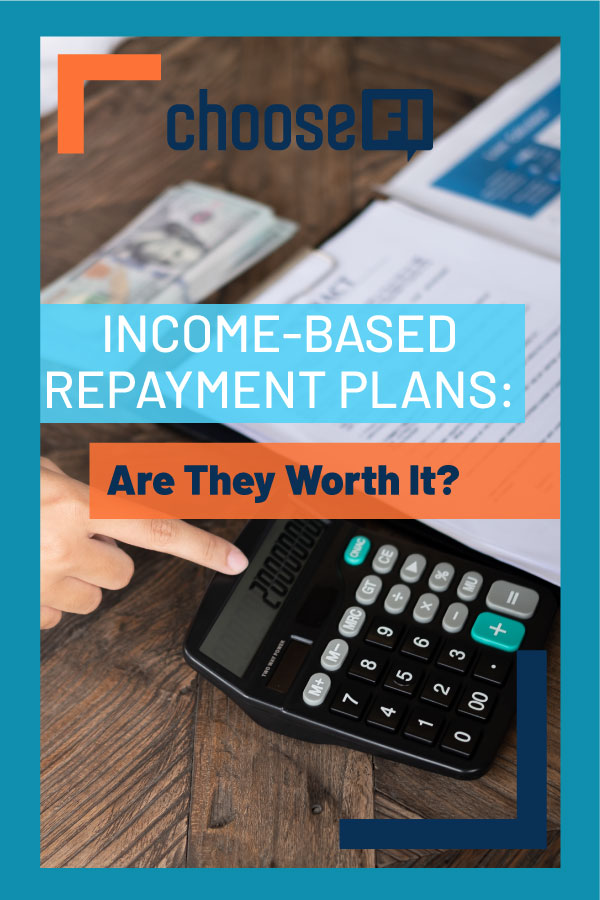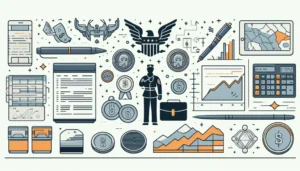One of the unique benefits of federal student loans is the ability to choose one of four income-based repayment plans.
The beauty of income-based repayment is that your payment scales up and down with your income. But, as with any federal program, understanding the various income-based repayment plans and their accompanies rules can be a complicated and confusing task.
Don’t worry. We’ve done all the research for you. In this guide, you’ll learn everything you need to know about student loan income-based repayment plans, how to qualify for them, and their pros and cons.
The four income-based repayment plans available today are PAYE, REPAYE, IBR, and ICR. With each of these plans, your monthly payment will be based on a percentage of your discretionary income and you’ll be eligible for forgiveness after 2o to 25 years. But in exchange for lower payments, you’ll pay more in interest and usually more overall.What Income-Based Repayment Plans Are Available Today?
There are four income-based repayment plans currently available:
- Pay As You Earn (PAYE)
- Revised Pay As You Earn (REPAYE)
- Income-Based Repayment (IBR)
- Income-Contingent Repayment (ICR)
As we’ll see below, all of these plans are similar at their core, but each has slight differences.
Income-Based Repayment Vs. Income-Driven Repayment: What’s The Difference?
One important thing to point out is that “Income-Based Repayment” is the actual name of the IBR plan.
And this can be confusing.
For instance, if you call up your loan servicer and say that you want to be placed on income-based repayment, they may take that to mean that you want to be placed on IBR.
But for most of us, that’s not what we mean. Most of us use the term “income-based repayment” to refer in a general sense to all four plans that base our payments on our income.
To avoid confusion, you’ll want to use the term “income-driven repayment,” when you’re talking to your loan servicer. In the technical sense, there is only one income-based repayment plan (IBR), while all four of the plans listed above are income-driven (IDR) plans.
For this article, we’ll use income-based repayment and income-driven repayment (IDR) interchangeably. But when we’re discussing the specific Income-Based Repayment (IBR) plan, we’ll simply refer to it as IBR.
How Long Will It Take Me To Receive Forgiveness Under Each Plan?
With each of the IDR plans, you’ll be eligible for forgiveness on your remaining balance after a certain number of years. Here’s how long you’ll have to wait before you’re eligible for forgiveness on each plan.
- PAYE–20 years
- REPAYE
- 20 years for undergraduate loans
- 25 years for graduate loans
- IBR
- 20 years if you’re a new borrower on or after July 1, 2014
- 25 years if you’re not a new borrower on or after July 1, 2014
- ICR–25 years
Keep in mind that if you don’t use an IDR plan, you’ll generally pay off your student loans in ten years. So you’ll be extending your repayment schedule by two to two and a half times by choosing one of the income-based repayment plans.
Yes, that means that your monthly payment will be lower. But you’ll also be paying interest for an extra ten to 15 years. That’s why it’s essential to consider your overall cost before deciding to go with an IDR plan.
Listen: Student Loan Repayment With Travis Hornsby
How Is Income-Based Repayment Calculated?
Your monthly payment on each of the income-based repayment plans will be based on your discretionary income.
“Discretionary income” means something completely different when we’re talking about income-driven student loan repayment than what it means in the general vernacular.
Typically, we think our discretionary income is whatever money we have left after covering our core expenses. But when it comes to student loan repayment, the Department of Education defines discretionary income differently.
In this case, your discretionary income is your adjusted gross income (AGI) minus 150% of federal poverty guidelines for your family size. See the federal poverty guidelines.
For example, let’s say “John” has a family of three and a $50,000 annual salary. For 2019, the federal poverty guideline for a family of three is $21,330. Remember though, John can deduct 150% of the federal poverty guidelines. To find that number, simply multiply the federal poverty guideline by 1.5.
In John’s case, we take $21,330 and multiply by 1.5.
$21,330 x 1.5 = $31,995
As you can see above, John would have a $31,995 deduction. So we subtract that number from Jim’s AGI.
$50,000–$31,995 = $18.005 (discretionary income)
So even though Jim has a $50,000 AGI, his discretionary income for income-based repayment is only $18,005.
What Percentage Of My Discretionary Income Am I Required to Pay?
With PAYE and REPAYE, you’ll generally pay 10% of your discretionary income.
You’ll pay 10% with IBR too, unless you weren’t a new borrower on or after July 1, 2014 (in which case, you’ll pay 15%). With ICR, you’ll generally be required to pay 20% of your discretionary income.
Using our example from above, Jim’s annual payment (in most cases) would be 10% of $18,005.
$18,005 x .10 = $1,880
Next, we need to take $1,880 and divide by 12.
$1,880 ÷ 12 = $150 (estimated monthly payment)
So, as you can see, John would be left with a monthly payment of around $150. Of course, that’s before interest charges are taken into account.
To get a more exact estimate of what you would pay each month on an income-based repayment plan, check out the StudentLoans.Gov Repayment Estimator.
Who Qualifies For Income-Based Repayment Plans?
Anyone with qualifying federal loans is eligible to join the REPAYE or ICR plans.
But with PAYE and IBR, the payment you would be required to make (based on your income and family size) must be less than what you’d pay under the Ten-Year Standard Repayment Plan.
How To Apply For Income-Based Repayment Plans
In order to apply for an IDR plan, you’ll need to fill out an Income-Driven Repayment Plan Request.
If you qualify for income-based repayment, you’ll then choose a specific plan. We’ll talk more a bit later about how to pick the right plan. But you’ll definitely want to do your research before joining a plan.
Can you switch plans later? Yes. But when you do any unpaid interest that you’ve accumulated will capitalize. So do your best to get it right the first time.
Fill out the Income-Driven Repayment Plan Request
Annual Recertification
Once you’ve been accepted to an IDR plan, you’ll need to recertify your income and family size every year.
Your loan servicer should notify you well ahead of time when you need to recertify again. The deadline will typically be around the same time of year that you joined the plan originally. But don’t procrastinate on recertifying your income. If you miss the income recertification deadline, you’ll be kicked off your income-based repayment plan.
Can you rejoin? Yes. But in the meantime, your payment will be much higher.
And if you were making payments via auto-draft, your bank account may be charged before you even notice the change. And, in some cases, this could lead to overdrafts and accompanying fees. Also, if your student loans have accumulated any unpaid interest, that interest will capitalize when you’re kicked off the IDR plan.
Finally, don’t forget to recertify your income and family size. If you only recertify your income, you’ll stay on the IDR plan, but your monthly payment will be based on a family size of one. If you have a medium to large-sized family, this could make a big difference in the size of your payment.
Basically, just don’t forget to recertify. Set a phone reminder, leave notes all around the house, or do whatever you have to do. But just make sure that you recertify before the deadline each year.
Which Of The Income-Based Repayment Plans Is Best?
There is no “best IDR plan.” But there may be a best income-based repayment plan for you.
In theory, your loan servicer should be able to tell you which plan would be best for your situation. But, unfortunately, not all federal loan servicer employees are created equal. Some are better trained than others.
If you’re having a hard time getting concrete answers about how to pick an IDR plan, here are a few things to keep in mind.
Student Loan Types
The first thing to consider is the type of student loans you have. If we’re talking about Parent PLUS loans, your only option is ICR (and even so, you’ll need to go through a Direct Loan Consolidation first).
If you have graduate loans, you may want to stay away from REPAYE. With REPAYE, undergrads are eligible for forgiveness after 20 years, but graduate borrowers aren’t eligible until 25 years have elapsed.
Marital Status
You may also want to stay away from REPAYE if you’re married or plan to be married soon.
REPAYE is the only plan that requires the income of both spouses to be included in the discretionary income calculation. With the other plans, you can choose to use your personal income alone as long as you and your spouse file your taxes separately.
Interest Accumulation
The one area where REPAYE shines is in how it handles unpaid interest. With PAYE and IBR, the government will pay some of your unpaid interest for the first three years of repayment.
But with REPAYE, the government will continue to pay half of the remaining interest on your unsubsidized loans for the life of the loans. This could make a big difference in the interest that you’ll pay over time and the amount of forgiveness that you receive.
Forgiveness From Income-Based Repayment Plans Is Taxable
If you do end up receiving student loan forgiveness with your income-based repayment plan, it’s important to understand that you’ll owe income tax on the forgiven amount.
So if you’re in the 25% tax bracket, for example, $50,000 of student loan forgiveness could generate a $12,500 tax bill or more.
This is another reason why choosing the REPAYE plan could be a smart move. By limiting the amount of interest that accumulates, you’ll also limit the amount of forgiveness that you receive. And that, in turn, will help you minimize your student loan forgiveness tax bill.
Regardless of the IDR plan that you choose, it’s important to plan for the “tax bomb” that’s coming down the road. If you put a little money away each year (for 20 to 25 years), you should be in good shape when the time comes.
Is Income-Based Repayment A Good Idea?
If it would be a struggle for you to make your monthly payments on the Ten-Year Standard Repayment plan, an income-based repayment plan could help relieve some of the burden. The great thing about income-based repayment is that your income scales up and down with your income. And there’s some security in that.
But the downside is that it will take you 20 to 25 years to repay your loans. And that means you’ll pay a lot more in interest. And, in many cases, you’ll pay a lot more overall with income-based repayment.
That being said, there are two times when you absolutely do want to choose an income-based repayment plan.
1. You Plan To Pursue Public Service Loan Forgiveness (PSLF).
If you work for the government or for a non-profit, you may be eligible for Public Service Loan Forgiveness (PSLF). And that’s a big deal because PSLF is probably the most generous federal student loan forgiveness program available today.
With PSLF, you can receive student loan forgiveness in as little as ten years (120 qualifying payments). Yes, that’s 2 to 2.5 times faster than the amount of time you’ll have to wait before receiving forgiveness on any of the IDR plans.
But, that’s not all. The forgiven amount with PSLF is also not subject to income tax. So you can receive forgiveness twice as fast AND you don’t have to deal with a tax bomb. That makes a PSLF a slam dunk for nearly all public sector workers.
But here’s the deal. You must be on an income-based repayment plan in order to qualify for PSLF. So if you plan to pursue PSLF, you need to choose income-driven repayment.
Learn more about Public Service Loan Forgiveness (PSLF).
2. Your Job Situation Is Uncertain.
If you’re in an unstable job situation, an income-based repayment plan may be a good choice. In that case, you’ll at least have the comfort of knowing that your student loan payments will be manageable no matter what happens with work.
On the other hand, if you expect your income to rise over the next few years, IDR plans may not benefit you as much. In that situation, you may want to consider refinancing your student loans to save on interest costs.
Related: Refinance Your Student Loans With Credible
Conclusion:
If you can pay off your loans in ten years or less, that’s typically your best financial move. But if cash flow is your biggest concern, an income-based repayment plan could give you the flexibility that you need.
Related Articles:
- Get Off The Hamster Wheel And Pay Off Your Student Loans Fast
- FI After College: Best Money Moves After Graduation
- Refinancing Student Loans: Pros And Cons You Need To Consider




